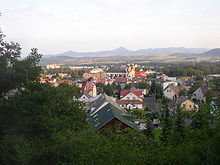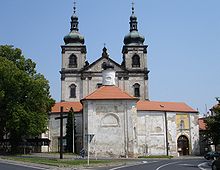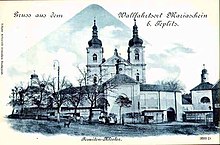Bohosudov
| Bohosudov | ||||
|---|---|---|---|---|
|
||||
| Basic data | ||||
| State : |
|
|||
| Region : | Ústecký kraj | |||
| District : | Teplice | |||
| Municipality : | Krupka | |||
| Area : | 202.256 ha | |||
| Geographic location : | 50 ° 41 ′ N , 13 ° 52 ′ E | |||
| Residents : | 4,014 (2011) | |||
| Postal code : | 417 42 | |||
| License plate : | U | |||
Bohosudov ( German Mariaschein ) is the central district of the city of Krupka in the Czech Republic . He is best known for the pilgrimage church of Our Lady of Sorrows , which is also known as Mariaschein after the former place name .
Geographical location
Bohosudov is located in northern Bohemia , seven kilometers northeast of Teplice . It is a district of Krupka and is located on its eastern side. Road No. 253 passes through the village and can be reached from Dubí or from Ústí nad Labem . Hikers from Fürstenau can also reach Bohosudov with the cable car from Komáří hůrka with a descent into the valley.
History of the place
Mariaschein developed gradually from the village of Althof with its 13th century moated castle and the village of Scheine mentioned in 1446 (also called Schein , Scheune ). In 1591 the village of Scheine fell to the Komotauer Jesuits , who began to build a convent and a pilgrimage church around 1650 , which they called Mariaschein. This name has been transferred to the two communities Althof and Scheine since 1670 . From the middle of the 19th century Mariaschein was a municipality in the judicial district of Karbitz or in the district of Außenig .
Due to the Beneš decrees , the German population had to leave Mariaschein after the Second World War . In 1959 it was incorporated into the city of Krupka. The seat of the Krupka City Council is located in Bohosudov.
Development of the population
|
|
|
History of the pilgrimage and the pilgrimage church Mariaschein
One of the many legends relates to the development of the pilgrimage that the nuns, whose monastery in Schwaz was burned down by the Hussites , fled to the Graupen forests. When escaping, they took a clay figure of Mary with them and hid it in a linden tree. According to another tradition, around 300 fighters who fled the battlefield near Aussig were killed by the Hussites here in 1424 .
The figure of Mary hidden in the linden tree is said to have appeared later to a girl in need. Then a wooden chapel was built on the square , in which the miraculous image of the Sorrowful Mother of God was placed and which was replaced by a stone building in 1443.
The first Marian pilgrimage took place in 1610. Some forty years later, the Jesuits began to build a sanctuary, which in the years 1701-1708 on behalf of the Counts Kolowrat by the Leitmeritzer diocesan architect Giulio Broggio and his son Octavio Broggio was remodeled baroque.
An enlarged representation of the miraculous image is located above the entrance portal between two interrupted round arches. In niches to the right and left of the entrance are statues of the Jesuit saints Ignatius von Loyola and Franz Xavier . The south side is decorated with statues of the Bohemian patrons Wenzel , Ludmilla , Johann von Nepomuk and Prokop , the north side the Saints Anna , Titus , Joseph and Adalbert .
The church has a rectangular floor plan with only one nave and three side chapels. It has a rich interior:
- The high altar with pillars canopy created 1704-1714 of the Tyrolean sculptor Franz Dollinger after the model of the altar of St. Peter's Basilica . He should stand at the place of the linden tree in which the image was found.
- The paintings on the side altars are by Ignaz Raab and Johann Georg Heinsch .
- The pulpit with the richly decorated sound cover was created by Franz Dollinger in 1719.
- The organ with a baroque prospect is adorned with figures of Saint Cecilia and King David as well as angels making music.
The church is surrounded by a cloister with seven chapels, which was built between 1584 and 1590. The chapels symbolize the Seven Sorrows of Mary and bear the names of the donors:
- The prophecy of Simeon at the sacrifice in the temple (Reichstädter or Herzoglichen Lauenburgischen)
- The Flight into Egypt (The princely Clary-Aldringensche or Teplitzer)
- The loss and the three days of searching for the boy Jesus (Leitmeritzer)
- The Meeting on the Way of the Cross (Die Bleylebensche)
- Standing under the cross (The Kulmer or Kolowratsche)
- The Descent from the Cross (Osseger)
- The Entombment (Die Duxer or Graflich Waldsteinsche)
The 37 frescoes in the cloister present the history of the pilgrimage site. There were a total of 31 confessionals in the cloister, above which biblical scenes are depicted in half-reliefs.
The well chapel was built between the church and the cloister , in which the spring, which is said to have beneficial effects, was placed.
In 1853 a boys' seminar was built next to the pilgrimage church , which was expanded in 1882. The grammar school was built in 1906 and gained public rights in 1922. By 1925 652 priests were trained here alone.
For the 500th anniversary of the pilgrimage in 1924, the Leitmeritz bishop Josef Gross achieved the elevation of the pilgrimage church to a minor basilica by Pope Pius XI. The layout of the church is the same as that of the church Al Gesu of Vignola in Rome, the main altar is a replica of the altar in St. Peter's Church . After the Second World War , the pilgrimage broke off. Only in 1968 was a pastor allowed to take over the care of the parish. After the political change of 1989, Lusatian Sorbs make pilgrimages to Mariaschein every July . In addition, a children's foot pilgrimage has been held every year from Dresden since 1992. The whole area is in need of renovation.
Carl Schneeweiß died in Mariaschein in 1887 as a Jesuit prior.
Convention building and grammar school
The convent buildings were built after 1668. In 1679 the Jesuits built a Latin school next to the convent. In the course of the Josephine reforms , the convent was dissolved in 1773 and a school and a preparatory facility for prospective teachers were set up in 1779 . In 1853 the episcopal grammar school was opened. During the German occupation, the building served as a police school. The school was closed again in 1950 by the Czechoslovak state. In the same year the convent buildings were designated as an internment camp for Czech Jesuits and members of other orders. A few years later the buildings were used as barracks for the Czechoslovak army , and after 1968 for the Soviet army, which did not leave Mariaschein until 1991. As early as 1993 the diocese of Leitmeritz was able to open a grammar school in the former convent building, which is structurally in a poor condition.
Sons and daughters of the place
- Ferdinand Laufberger (1829–1881), painter and etcher
- Ferdinand Habel (1874–1953), musician, cathedral conductor at St. Stephen's Cathedral in Vienna
- Franz Joseph Bendel (1875–1950), Catholic theologian, archivist and historian
- Ferdinand Josef Schneider (1879–1954), literary historian
- Friedrich Reimann (1896–1991), painter
- Herta Lindner (1920–1943), resistance fighter and mountaineer
- Peter Fiedler (1940–2009), theologian
See also
literature
- Joachim Bahlcke , Winfried Eberhard, Miloslav Polívka (eds.): Handbook of historical places . Volume: Bohemia and Moravia (= Kröner's pocket edition . Volume 329). Kröner, Stuttgart 1998, ISBN 3-520-32901-8 , pp. 366-367.
- Publication : Bazilika Panny Marie Bolestné . Published by the City of Krupka 2006.
- Johannes Schwabstedt: Sudeten German home low mountain range, the history of a German landscape . Herklotz, Marburg / Lahn 1954.
- Michael Hoffmann: Mariaschein - Bohosudov. A place of pilgrimage in deep sleep . Kirchhof & Franke, Leipzig / Marek, Brno 2005, ISBN 3-933816-34-3 (Leipzig) / ISBN 80-86263-71-1 (Marek).
- August Müller: The origin of the place Mariaschein. In: Erzgebirgs-Zeitung , 52nd year, 1931, pp. 50–63. ( Digitized version )
Web links
- Michael Hoffmann: Mariaschein - Bohosudov: a place of pilgrimage in deep sleep. Retrieved April 13, 2014 .
- Detailed information with photos on viamariana.com
Individual evidence
- ↑ http://www.uir.cz/katastralni-uzemi/675288/Bohosudov
- ↑ a b c Historický lexikon obcí České republiky - 1869-2015. Český statistický úřad, December 18, 2015, accessed on January 25, 2016 (Czech).
- ↑ full text
- ↑ Information on the children's foot pilgrimage on the website of the Dresden-Meißen diocese, accessed on November 26, 2012






